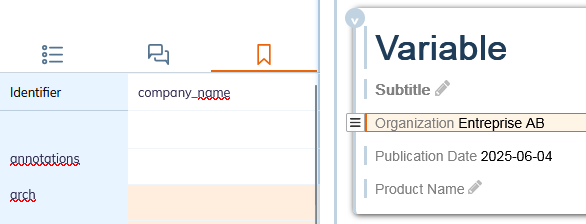6. To configure
6.1. Use content in multiple places in a document
The parameter-variable Allows content to be used by its value in multiple places in a document. This means is an alternative to reusing content within the same document.
The value of the item parameter-variable is used at the time of publication.
To insert a parameter-variable:
Specify an identifier (see To identify) on the element that contains the text to be reused. It is often an element of the block “information” of the document such as a product name, organization, version number, etc.
Position the cursor where you want to insert the parameter-variable.
Click on → .
Set the identifier of the variable, in the black background of the element.

6.2. Choose the orientation of the content on the page
This setting works for style sheets produced with the PDF Layout Studio PDF Layout Studio.
Types of items that can change orientation:
section
any block element (table, media, figure, lists) within the structural elements (chapter, appendix, etc.) or within sections
Supported page formats:
A4
A3
Two types of content orientation:
portrait
landscape
To set the orientation of an element:
Select the item in the editor.
Place the desired value in the
remapIn the list of attributes:The value syntax for the
remaplandscape or a4; landscape;
a4; portrait;
a3; portrait;
a3;landscape.
For the very first setup, open the stylesheet in the studio and resave it so that the orientation choice is taken into account for publishing. |
You can combine this setting with the configuration of the style sheet in portrait/landscape mode in the menu . |

